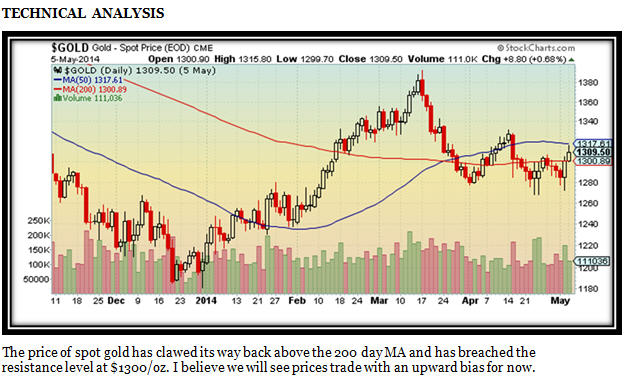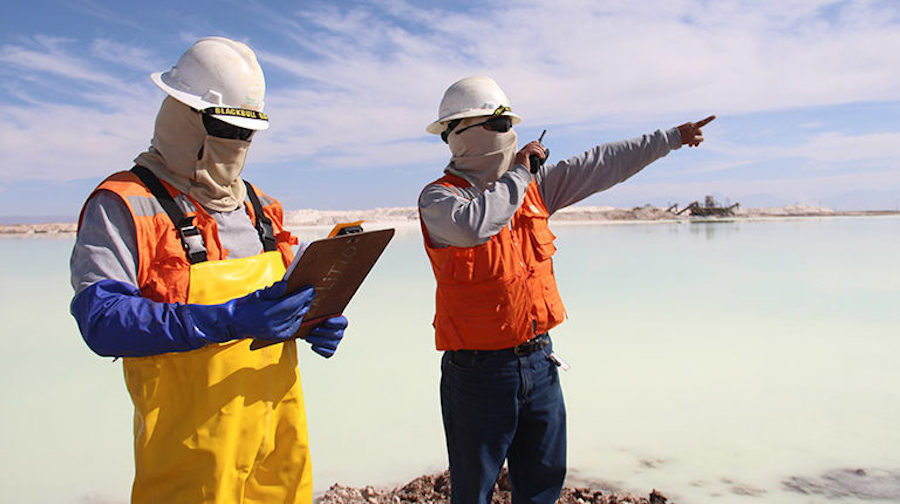Geopolitical tensions particularly in Ukraine continue to dominate the gold market
Despite a mainly negative sentiment towards gold from investors as evidenced in the continued liquidation in gold-backed exchange-traded funds amid signs of an improving U.S. economy, the crisis in Ukraine has prompted in recent safe-haven buying which helped boost the price of gold to three-week highs above $1,300 an ounce.
In the last few days, the situation in Ukraine has deteriorated and looks to be spiralling out of control.
On Friday, the US Labour Department reported that U.S. employers hired workers at the fastest pace in more than two years in April, pointing to a rebound in economic growth. The all-important US employment data which was released on Friday, failed to put pressure on gold prices. Non-farm payrolls saw the largest gain since January 2012 in April, surging to 288,000 last month and beating Wall Street’s expectations for an increase of 210,000, the US Labour Department said on Friday.
The unemployment rate dropped by 0.4% to a five-and-a-half-year low of 6.3%, part of the decline was because hundreds of thousands of people left the labour force.Violence broke out on Friday and more than thirty people were reported dead in a fire linked to riots in Ukraine port of Odessa. Ukrainian authorities said 31 people died in the blaze at the city’s trade union building on Friday evening. Twenty-three of the victims died of carbon monoxide poisoning and eight died after leaping from upper storey windows to escape the flames, the Interior Ministry said in a statement.
In another separate event that also took place on Friday, pro-Russian rebels shot down two Ukrainian helicopters near separatist-held Slaviansk, killing two crew members, while Moscow accused Kiev of wrecking hopes of peace by launching a “criminal” assault to retake the eastern town.
Overall, the solid report suggests that the economy is gathering momentum and will induce investors to pull forward their bets on when the US Federal Reserve (US Fed) will raise interest rates.
US Treasury debt yields soared after the report, while the dollar jumped to session highs against the euro and the yen.
Last Wednesday, the US Federal Reserve announced a further reduction of its economic stimulus efforts, after a two-day meeting in Washington.
The central bank said it would continue trimming its monthly bond-purchases by an additional $10bn (£5.9bn) to $45 billion.
The bank has been buying bonds to keep long-term interest rates low and stimulate economic activity.
Fed chair Janet Yellen said the bank will continue to support the US economy for as long as it deems necessary.
The Fed ignored the dismal first-quarter performance which showed that the US economy grew at an annual rate of only 0.1% in the first quarter 2014.
However, it seems that the situation in Ukraine which is causing a stand-off between the US, Europe and Russia will dominate the gold market. And, as I believe that tensions will escalate, I expect to see prices pushing higher.
Ukrainian troops have encountered pro-Russia militia in Slovyansk. Associated Press reporters heard gunfire and multiple explosions in and around Slovyansk, a city of 125,000 people that has become the focus of the armed insurgency against the new interim government in Kiev.
In the last few weeks, anti-government forces have stormed and seized government buildings and police stations in a dozen eastern Ukrainian cities. Authorities in Kiev — who blame Russia for backing the insurgents — have up to now been largely powerless to react. And since Russia has kept tens of thousands of troops along Ukraine’s eastern border — and annexed its key Black Sea peninsula of Crimea last month — Ukraine’s central government fears Russia could try to invade and grab more territory.
Since the government began trying to take back the buildings late last week, Slovyansk has been under a tight security cordon. Movement in and out of the city has ground almost to a halt, causing shortages in basic supplies. Lines have been seen at grocery stores.
The goals of the insurgency are ostensibly geared toward pushing for broader powers of autonomy for the region, but some insurgents do favour separatism and the annexation of Crimea looms over the entire political and military discussion.
Russia, which the international community has accused of promoting the unrest, has vociferously condemned Ukraine’s recent security operations in the east.
Last week The US government announced that they will freeze the assets and impose visa bans on seven powerful Russians close to President Vladimir Putin and also sanctioned 17 Russian companies in reprisal for Moscow’s actions in Ukraine. Among those sanctioned was Igor Sechin, head of state energy giant Rosneft.
The United States will deny export licenses for any high-technology items that could contribute to Russian military capabilities and will revoke any existing export licenses that meet these conditions, the White House said.
After the announcement by the US government, Russia’s armed forces chief of staff and its military intelligence chief were among 15 people targeted by the European Union’s latest sanctions over the Ukraine crisis.
General Valery Gerasimov, army chief and the country’s deputy defence minister, were named in the EU’s official list along with Lieutenant-General Igor Sergun, director of Russia’s GRU, or main intelligence directorate.
Another GRU officer, Igor Strelkov, was also placed on the list for “incidents in Slavyansk”.
Several officials involved in the March annexation of Crimea by Russia were also listed along with Ukrainians held responsible for trouble in the country’s east, including “Donetsk Republic” leaders Denis Pushilin and Andriy Purgin.
The latest list brings to 48 the number of people to be hit by an EU asset freeze and travel over the annexation of Crimea and unrest in eastern Ukraine.
Another 22, all Ukrainians, also have had their assets frozen in the 28-nation bloc because they are being investigated for fraud and embezzlement by the interim Ukraine authorities.
Among those placed on the EU blacklist over the annexation of Crimea are two deputy state Duma chair people, Sergei Neverov and Ludmila Shvetsova, as well as the acting governor of annexed Sevastopol, Sergei Menyailo and deputy premier Dmitry Kozak, who oversaw Crimea’s integration into the Russian federation.
Others listed over Crimea are Oleg Belaventsev, Oleg Savelyev and Olga Kovatidi.
Ukrainians targeted for separatist activities include German Prokopiv and Valeriy Bolotov, both allegedly involved in the seizure of official buildings in Lugansk.
One of the leaders of the separatist People’s Militia of Donbass, Sergiy Tsyplakov, was also named.
Violence broke out on Friday and more than thirty people were reported dead in a fire linked to riots in Ukraine port of Odessa. Ukrainian authorities said 31 people died in the blaze at the city’s trade union building on Friday evening. Twenty-three of the victims died of carbon monoxide poisoning and eight died after leaping from upper storey windows to escape the flames, the Interior Ministry said in a statement.
In another separate event that also took place on Friday, pro-Russian rebels shot down two Ukrainian helicopters near separatist-held Slaviansk, killing two crew members, while Moscow accused Kiev of wrecking hopes of peace by launching a “criminal” assault to retake the eastern town.
Separatists said Ukrainian forces killed three of their fighters and two civilians when they moved in on Slaviansk in the early hours, but that the troops had only taken five checkpoints from the rebels.
The West continues to accuse Moscow of provoking the unrest in eastern Ukraine, something Russia denies.
US President Barack Obama, at a meeting with German Chancellor Angela Merkel at the White House, warned of further sanctions against Russia if it did not “change course”.
He said the idea that the unrest was caused by a “spontaneous uprising” was “belied” by the militants’ use of missiles.
Ukraine’s government has said the country is now “at war” with pro-Russia insurgents as the Kremlin warned that it had received “thousands” of pleas for help from inside its neighbour.
As fighting raged around the town of Kramatorsk in the eastern region of Donetsk, Ukrainians took stock of the worst bloodshed since the February Revolution.
So far, however, Ukraine’s army has not yet attempted a full scale assault to retake the town while Russia has already amassed between 35,000 and 40,000 troops on Ukraine’s eastern frontier, stockpiling enough fuel, ammunition and medical supplies – including a chain of field hospitals – for this army to be able to mount an invasion within 12 hours of receiving the order.
John Kerry, the US secretary of state, spoke to his Russian counterpart, Sergei Lavrov, by telephone. The opposing demands of the two men showed their totally opposing views of the crisis. Mr Kerry said that Russia must “withdraw support for the separatists” and begin to “de-escalate the situation”.
Mr Lavrov, by contrast, said the burden of restoring calm rested on America. He urged Washington to restrain the Kiev government and, in particular, force a halt to the military offensive in the east that was “pushing the country towards a fratricidal conflict”.
This week has seen the start of India’s second biggest gold buying festival Akshaya Tritiya. During the festival it is widely viewed as auspicious to purchase gold jewellery, and as India is the second largest consumer of physical gold, demand looks set to rise. The Indian government still imposes a hefty $100 an ounce tax on imported gold, and only at the end of this festival will we see how badly that has tempered demand.
Three central banks will meet this week including RBA, ECB and BoE.
By David Levenstein
About the author
David Levenstein is a leading expert on investing in precious metals . Although he began trading silver through the LME in 1980, over the years he has dealt with gold, silver, platinum and palladium. He has traded and invested in bullion, bullion coins, mining shares, exchange traded funds, as well as futures for his personal account as well as for clients.
His articles and commentaries on precious metals have been published in dozens of newspapers, publications and websites both locally as well as internationally. He has been a featured guest on numerous radio and TV shows, and is a regular guest on JSE Direct, a premier radio business channel in South Africa. The largest gold refinery in the world use his daily and weekly commentaries on gold.
David has lived and worked in Johannesburg, Los Angeles, London, Hong Kong, Bangkok, and Bali.
For more information go to: www.lakeshoretrading.co.za
Information contained herein has been obtained from sources believed to be reliable, but there is no guarantee as to completeness or accuracy. Any opinions expressed herein are statements of our judgment as of this date and are subject to change without notice.
{{ commodity.name }}
{{ post.title }}
{{ post.date }}


Comments